Circulation in the atmosphere
Storyboard 
Convection is the main generator of atmospheric circulation. This occurs as a result of the temperature difference that occurs for example at the equator where the radiation is maximum. This movement generates a pattern of different flows, both close to the surface and in height, which are key to understanding the flows in the ocean.
ID:(1581, 0)
Convection
Description 
The primary driving force behind atmospheric motion is known as the convection phenomenon. This occurs when air at the Earth\'s surface is heated by solar radiation absorbed by the ground. The heating causes the air to expand, making it less dense than the surrounding air, and as a result, it tends to "float" or ascend. As it rises, it creates a void that leads to surface winds replenishing the missing air mass, creating a space that eventually drags the cooled, descending air mass back down. This circular motion is formed.
This type of movement is not only observed in the atmosphere but also in a household, and it is part of the mechanism for distributing the heat generated by a radiator.
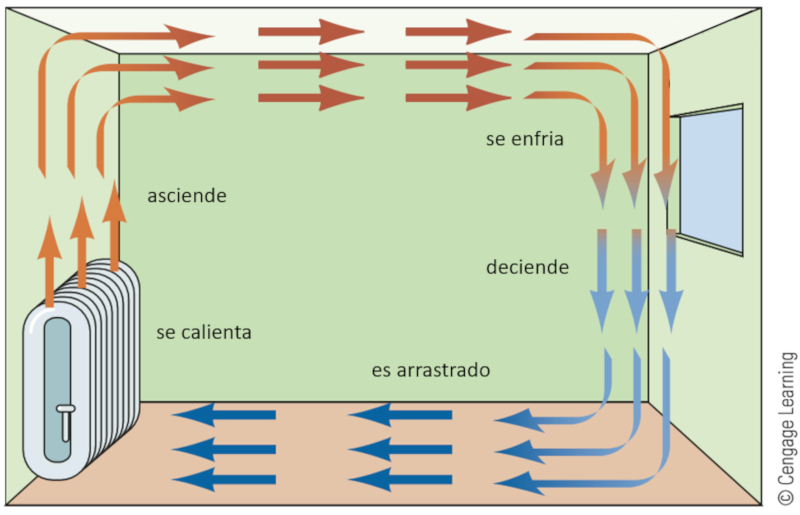
ID:(11737, 0)
Surface and height circulation
Description 
On the planet, the areas that receive more solar radiation, heat up more and generate more convection along the equator. The air rises and in the troposphere begins to disperse towards the north and south, inducing a circulation with surface winds towards the equator and high-level winds moving away from it.
The air at higher altitudes tends to cool down and then begins to descend to be carried at the surface towards the equator again. This forms a type of circulation belt around the planet known as the Hadley cells in the northern and southern hemispheres. These cells, in turn, induce an opposite circulation pattern that presents surface currents towards the north and high-level currents towards the south. These second cells are called Ferrel cells. Finally, there is a third cell known as the polar cell.

ID:(11738, 0)
Convection at the equator
Description 
The convection observed at the equator gives rise to air that is heated at the surface, absorbs a large amount of water vapor, ascends, and eventually generates clouds through the condensation of water vapor. This condensation is visible in the clouds that form throughout this region, where the surface winds from both hemispheres converge, known as the tropical convergence zone.
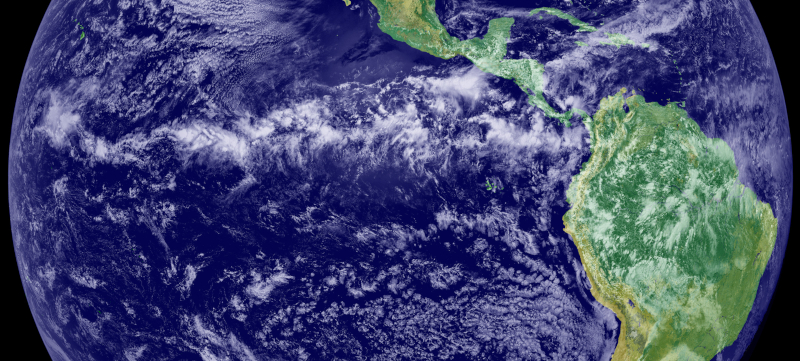
The mixing and convection of these air currents are highly unstable and lead to frequent storms and turbulence. If one frequently flies between South America and Europe, they will often pass through this zone during the night, experiencing frequent turbulence for about an hour. Sometimes, one can even observe lightning from the storms occurring in the lower layers of the atmosphere.
ID:(11740, 0)
Currents on the surface
Description 
If we focus on surface currents, we can identify three types of winds:
- In the Hadley cell, which extends from the equator to latitudes $\pm$ 30 degrees, winds tend to "advance" as they move from a zone of high tangential velocity to a zone of low tangential velocity (trade winds).
- In the Ferrel cell, which spans from latitudes $\pm$ 30 degrees to latitudes $\pm$ 60 degrees, winds tend to "recede" as they transition from a zone of low tangential velocity to a zone of high tangential velocity (westerlies).
- In the polar cell, which extends from latitudes $\pm$ 60 degrees to the respective poles, winds tend to "advance" as they transition from a zone of high tangential velocity to a zone of low tangential velocity (easterlies).
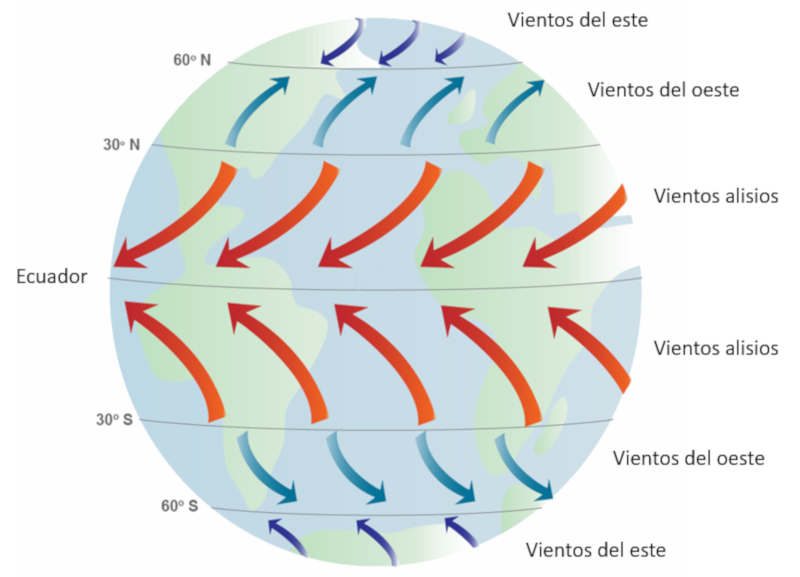
ID:(11739, 0)
Jet streams
Description 
At the points of conjunction between the Hadley and Ferrel cells, and between the Ferrel and Polar cells in the troposphere, a current is created that circulates around the planet. These currents are known as jet streams, specifically the subtropical jet stream and the polar jet stream. They circulate at high speeds and are used by aviation to shorten travel times from west to east:
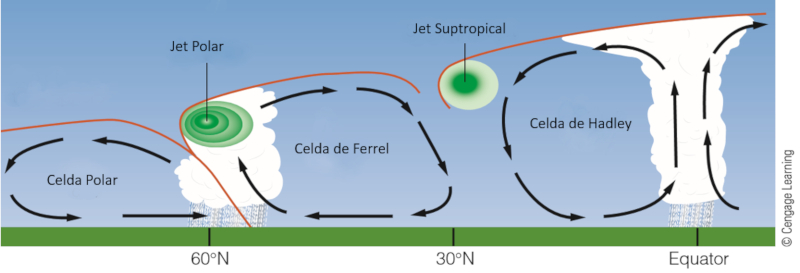
ID:(11745, 0)
Generation of high and low pressure zones
Description 
In general, the number of cells on the planet depends on the stability of the flow from the equator to the surface or from the equator to the upper atmosphere. In theory, the planet could have a single cell extending from the equator to the poles. However, currently we have three of these cells that form belts around the planet, where the currents converge between the Hadley cells and between the Ferrel and polar cells. The convergence of atmospheric flows in these regions indicates areas of low pressure. Similarly, high-pressure areas are expected to exist between the Hadley and Ferrel cells, as well as at the poles. However, these pressure belts tend to be unstable, fragmenting and generating zones of high and low pressure that move with the surface currents:

ID:(11744, 0)
Displacement of patterns in the atmosphere
Image 
The areas of low pressure (equator and 60 degrees latitude) and high pressure (30 degrees latitude and poles) not only segment and form centers that move with the currents but also meander around different locations (equator, 30 degrees latitude, 60 degrees latitude) influenced by seasonal temperatures in each hemisphere.
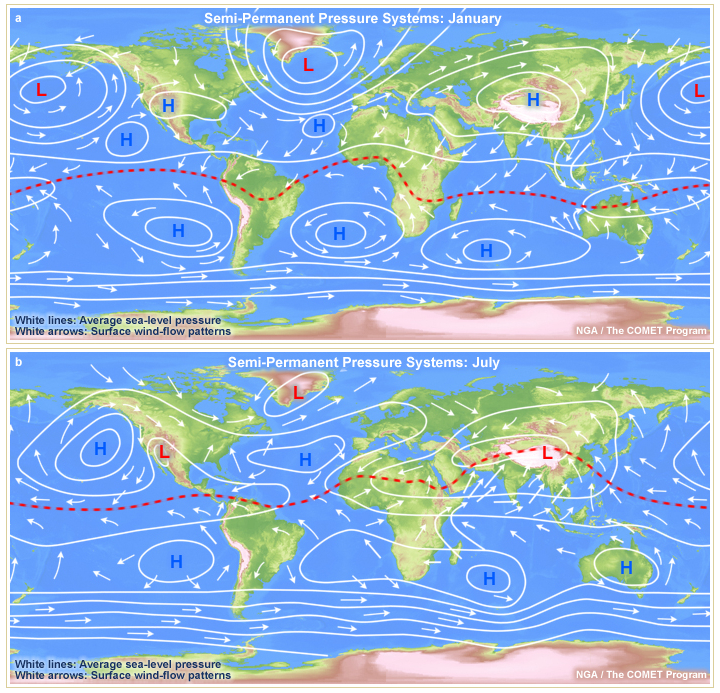
The red line on the diagram shows the position of what would be the tropical convergence zone, which meanders between both hemispheres.
ID:(11743, 0)
Vortex generation in the ocean
Description 
As the atmosphere drives the movement of the ocean surface, we can observe the corresponding circulation patterns that give rise to different winds. This helps us understand the large-scale circulation movements in:
- North Atlantic
- South Atlantic
- North Pacific
- South Pacific
- Indian Ocean
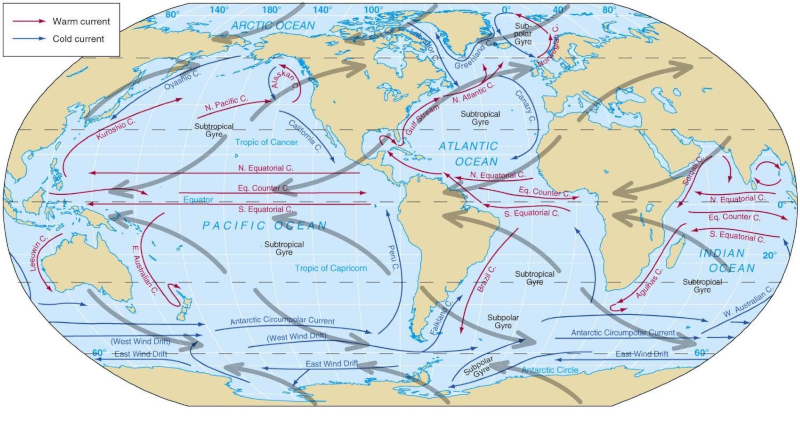
ID:(11741, 0)
Currents in the ocean
Description 
The ocean circulations have finer structures at the edges of the five major circulation zones. Due to inertia, these circulations persist over time despite the strong fluctuations in air flow.
Beyond the general circulation, there are specific flows north of Europe, around India, and in Oceania. These flows are smaller and do not exhibit the same inertia as the larger circulations. They are also subject to the more random movements of atmospheric circulation.
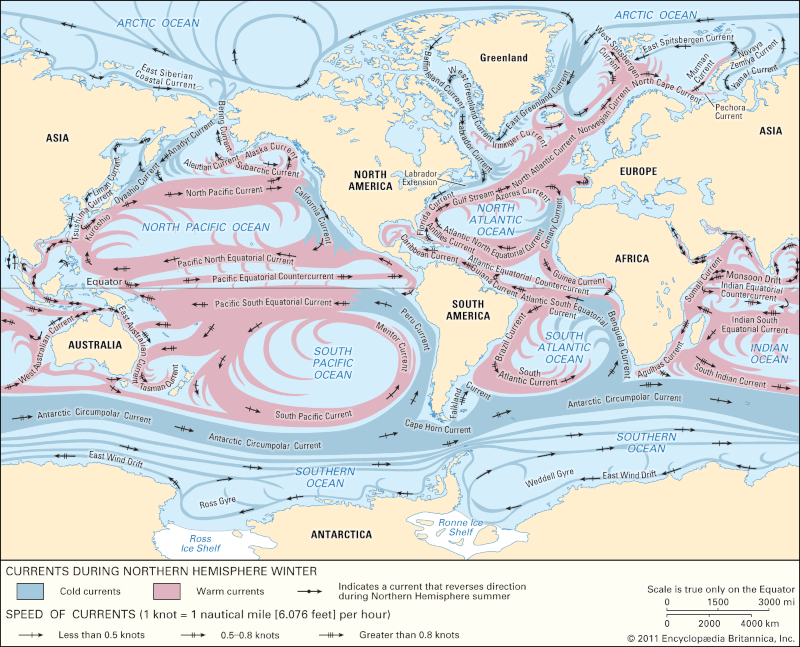
ID:(11742, 0)
Day current
Description 
Another type of minor circulation occurs along the coast. It doesn\'t affect the "macroclimate," only the local climate. During the day, the land absorbs a lot of energy and transfers some of it to the air masses, which heat up and undergo convection, starting to rise. This drags the air from the sea outward, creating the coastal wind observed at the beach. This onshore wind also drags the water from the sea, promoting wave formation.

ID:(11746, 0)
Night stream
Description 
However, during the night, the flow is reversed. Due to the high thermal capacity of water, it is now the ocean that transfers energy to the air, leading to convection over the ocean and dragging air from the coast. This creates a wind that blows from the coast out to sea, which in turn tends to calm the waves as it pulls the water offshore.
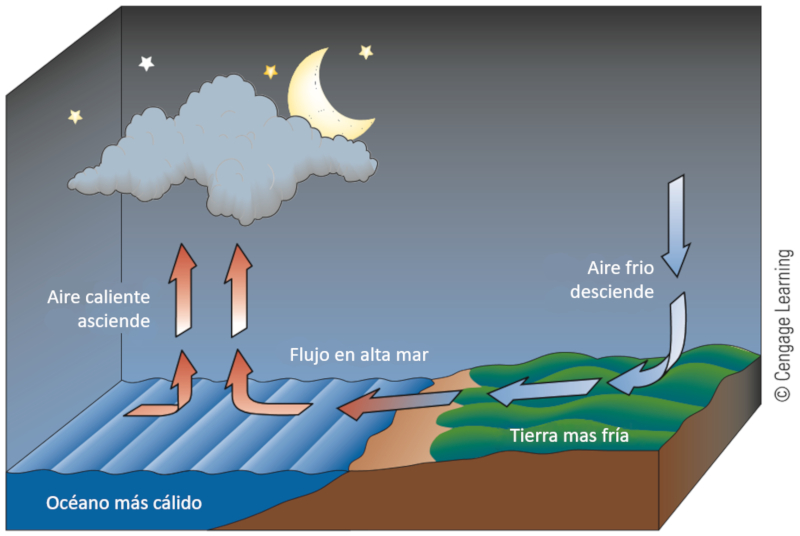
ID:(11747, 0)
